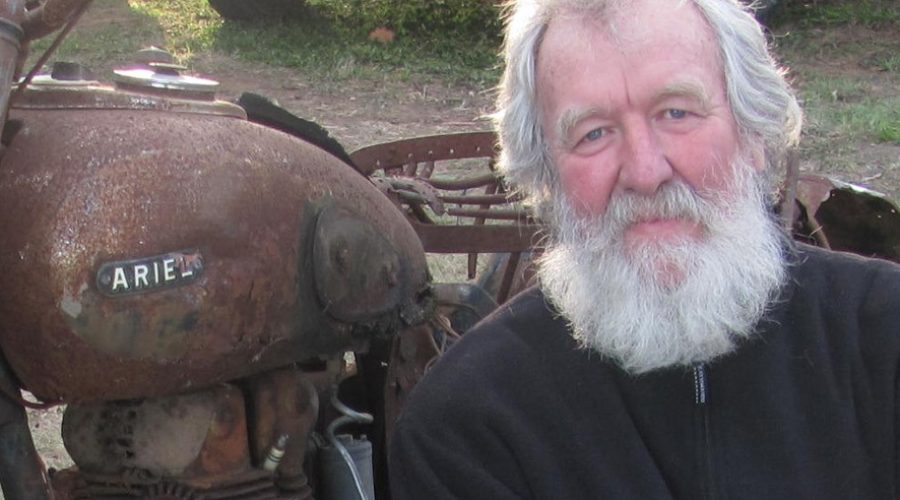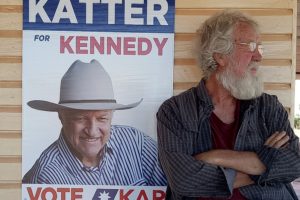Grant Roff
Grant Roff contributed in several capacities to Two Wheels over five decades. A supremely gifted writer, his Groff column was a must read in the magazine.
In recent years he served as Editor of Motorcycle Trader magazine and today, as Spannerman, he contributes to infomoto.com.au
This story was written for the 35 Years of Two Wheels special issue, in 2003. In 2012, he achieved a lifelong ambition – albeit in tragic circumstances following Jeremy Bowdler’s death – and became Editor of Two Wheels.
In recent years, I’ve been just about the only TW columnist who wasn’t a former editor of the magazine. A farmer friend, Peter Hickey, has a special place on his property which he calls “doggy hollow”. It’s where useless farm dogs go on their last, one-way, adventure walk. I suppose you can’t do that with old editors – they’d be suspicious if you invited them into a secluded location while you were carrying a .22 and only enough Stones for one.
I’ve been an editor of other magazines, though, the biggest of which was Royalauto, the journal of Victoria’s state motoring organization. My finest achievement with Royalauto was changing its shape from a floppy, A3 size, daggy publication to a svelte, modern, groovy, A4 size. I spent a year-and-a-half on the project and, as far as I can tell, despite having an audited one million readers each month, nobody noticed.
That’s not entirely true: I did get one letter. It was from a farmer who complained that he used to be able to fit two pairs of gumboots on an opened Royalauto at his back door but, with the new format, he could only fit one pair.
I spent a few nights in bed with my eyes open contemplating how much of my life I’d wasted working on a magazine nobody read. I think we make similar mistakes with TW on occasions when we agonise over changes which only we care about. Compared with Royalauto, though, TW is demonstrably better appreciated.
My own collection dates back to March 1970 and, while I don’t have a full set, I’ve probably got 250 or so magazines in the garage shelves. I know people with near-compete and complete sets. Anyone who has a complete set of Royalauto should get in touch but I won’t hold my breath.
While my earliest TW is from 1970, I was barely alive then. I collected them from second-hand shops later when I was after particular road tests. The March 1970, issue had a test of the T500 Suzuki which I was considering buying when it was 10 years older but much cheaper than the $775 new price. On the back page of that issue was an ad for two new Velocettes – the Thruxton for $1095 and the cheaper Sportsman for $989. Hard to believe now, but then the T500 was faster and more desirable.
I wrote my first story for the magazine in October, 1978. It was a touring yarn which the then editor, Mac Douglas, enjoyed because it was about what he himself liked doing: riding and drinking. I have the payment details on a cheque stub on the wall of my garage. The assistant editor, Brian Woodward, now sadly dead, became a mate, and I still dine out on his divorce stories.
“We argued for around three years about custody and property and, eventually, I was so sick of it I told my solicitor to give her everything. He said: “You don’t think she’ll be happy with just that, do you?” She wasn’t!”
Not long after that I submitted a story about the University of New England Motorcycle Club’s trip to a Castrol Six-Hour. The then-president, Bill McKinnon, couldn’t believe a national magazine would run a story on our humble club. The vicepresident, John Rooth, couldn’t believe it either. Both went on to become editors of TW. Mick Matheson was another UNEMCC member to progress to the TW hot seat.
By the time you get to read this, McKinnon, Rooth, Matheson (I think) and myself will have just attended the UNEMCC 25-year reunion in Armidale. It should be a hoot. None of us ever grew up and we still spend our time trying to be faster than each other on the road and trying to stay up later than each other in the pub. Bikes are like the circus: if it’s in your blood it’s pointless trying to fight it.
Thirty-five years is a pretty substantial innings for a magazine. Here’s a good way to think about it. If you go backwards 35 years from 1968 you might have found yourself in the design studios of the British company, Ariel, sitting alongside Edward Turner working on either the Square Four or the Red Hunter. Once Turner had noticed you, he would have told you to f*** off (he was like that) but if you’d hung around for a few more years when the owner of Ariel, Jack Sangster, bought Triumph and moved Turner in as chief designer, you would have seen Turner map out arguably the second most significant engine of last century – the model T Speed Twin.
You could also argue that nothing much happened in terms of motorcycle design between then and 1968 when the single-cam Honda Four appeared. Had TW started in 1933, you wouldn’t have had 35 years of magazines, rather the same magazine 420 times. A world war, however, provides a perfectly legitimate excuse for these years of apparent design lethargy.
Bang. 1968. TW fires up at the same time as a four-cylinder 750 which can crawl up to 190km/h, lasts for 160,000km, has an electric start, doesn’t vibrate and doesn’t leak oil. So much has happened with bikes since then that sometimes it wasn’t possible to contain the monthly update information between the TW covers. Those of us who’ve been privileged to live through the past 35 years can use TW as a kind of totem – diary. It reflected what was going on in the world (mercifully, I never grew a moustache or wore platform soles in the ’70s) as well as the phenomenal developments in motorcycle design and execution. The ’37 Speed Twin would still have been a contender for Bike of the Year in 1967, but imagine a current comparo between a K1 Honda 750 and a Yamaha R1. We’ve really lived in the golden years.
Two Wheels has, however, had its periods of drama and scandal.
The excellent Brian Cowan ran the magazine for years with, literally, one arm – the other a victim of a crash on a Ducati. BIKE Australia, a competitor magazine set up by current columnist Peter Thoeming (the deal secretly executed while he was actually TW Editor) in the early ’80s pushed TW to the limit of financial viability.
Then there were hard-nosed editors like McKinnon who would sack road-testers for minor technical errors and the shift to outlaw editorial values with John Rooth which clashed on occasions with the magazine’s traditional conservatism.
There was a lot of courage, too, my favourite example being possibly the only honest appraisal in the world of the first Honda V-four, the VF750S. Almost every other bike magazine was blinded by the emperor’s new clothes but the cover line on TW read: “V-Flawed”.
It’s been a wild trip and my small part on the SS Two Wheels as sometimes fifth or sixth mate has been one of the stabilising forces in an otherwise erratic life. It’s an admirable ship – long into the future may it sail…
By Grant Roff. 35 Years of Two Wheels, 2003.


